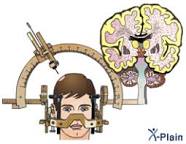 Pallidotomy is a neurosurgical procedure, used to treat Parkinson’s disease and some other conditions, often as an alternative to deep brain stimulation.
Pallidotomy is a neurosurgical procedure, used to treat Parkinson’s disease and some other conditions, often as an alternative to deep brain stimulation.
Pallidotomy is a surgical procedure that involves the destruction of a small part of the globus pallidus, a structure located in the brain that is involved in the regulation of voluntary movements.
It involves placing a tiny electrical probe in the globus pallidus, one of the basal ganglia of the brain, to damage it.
Unilateral pallidotomy can cause side effects including problems with language learning, visuospatial constructional ability, and executive functions.
Bilateral pallidotomy is not effective, with many severe side effects.
The internal globus pallidus is regarded as an output structure of the basal ganglia.
It processes input from nucleus accumbens and the striatum, and sends input to the cerebral cortex via the thalamus.
It is critical for the functioning of the basal ganglia.
Pallidotomy is an alternative to deep brain stimulation for the treatment of the dyskinesias which can become a problem in people with Parkinson’s disease after long-term treatment with levodopa.
Pallidotomy may sometimes used to treat essential tremor as an alternative to deep brain stimulation, and for dystonia, and hemiballismus.
Unilateral posteroventral pallidotomy is associated with impaired language learning, if performed on the dominant hemisphere, or impaired visuospatial constructional ability, if performed on the non-dominant hemisphere.
Pallidotomycan also impair executive functions.
Bilateral pallidotomy will not reduce Parkisonistic symptoms, but will cause severe apathy and depression, along with slurred, unintelligible speech, drooling, and pseudobulbar palsy.
The surgery itself can cause complications: intracranial hemorrhage, damage to the optic tract, and pressure on brain tissue can induce a seizure.
An electrical probe is placed in the globus pallidus, one of the basal ganglia of the brain via a craniotomy.
The probe is guided based on stereotactic information, and sometimes magnetic resonance imaging.
The globus pallidus is heated for a short time to destroy a small area of brain cells.
The procedure is usually done on one side of the brain and is used to treat movement disorders such as Parkinson’s disease or dystonia.
The goal of pallidotomy is to reduce the amount of abnormal activity in the globus pallidus, which can help to reduce symptoms such as tremors, stiffness, and difficulty with movement.
The procedure is performed under general anesthesi, using specialized imaging techniques to guide the placement of a probe into the targeted area of the globus pallidus.
The surgeon uses either heat or electric current to destroy the targeted tissue.
Patients may experience some weakness or numbness on the side of the body opposite the side where the pallidotomy was performed, but these symptoms usually improve over time.
Pallidotomy is not the first-line treatment for movement disorders and is typically reserved for patients who have not responded well to medications or other types of surgical treatments.
